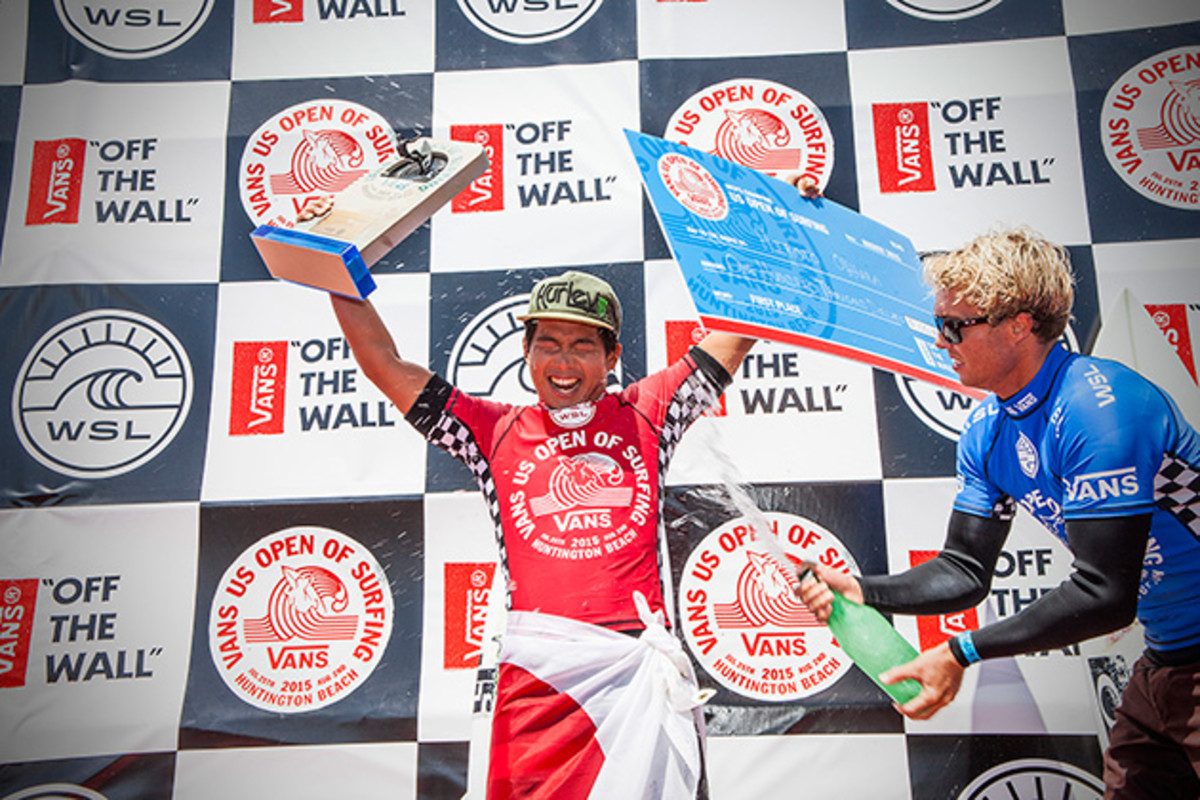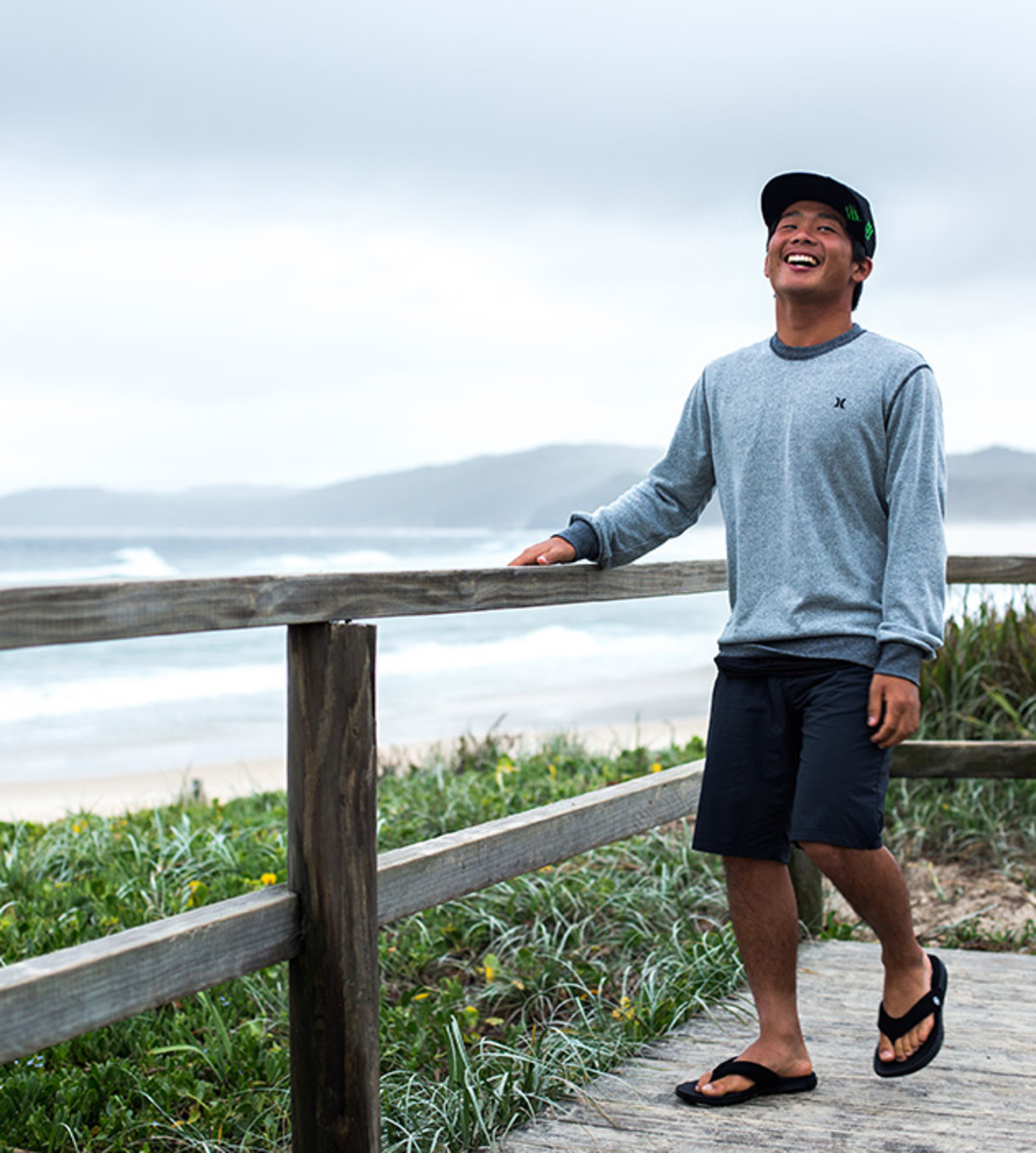Japan's Hiroto Ohhara is earning his place on surfing's biggest stage

The nearly 40,000 spectators packed along the pier and shoreline of Huntington Beach, Calif., at the U.S. Open of Surfing on Aug. 2 had probably never heard of Hiroto Ohhara before this year’s contest. But when the 18-year-old regular footer from Japan was chaired up the beach after the final heat, chants of his name echoed as loud as the waves crashing at Pipeline.
Standing atop the stage during the awards ceremony, a Japanese flag wrapped around his waist like a beach towel, Ohhara grinned as he raised a giant blue check for $100,000 above his head.
“I just want to try to get a drivers license and then get some cars,” Ohhara said with a laugh when asked what he planned to do with the prize money.
For the past month, Ohhara has indeed been in the driver’s seat. On that first weekend in August, he became the first Japanese surfer to win the U.S. Open—commonly regarded as the “world's biggest surf contest."
A week earlier, he had taken down an impressive list of other Hurley-sponsored surfers, including Alejo Muniz and Conner Coffin, to win the Hurley Trials in San Clemente. The victory earned Ohhara a wildcard berth into the Hurley Pro at Trestles, the eighth stop on the World Surf League’s Championship Tour, which begins Sept. 9.
San Clemente was supposed to have been the end of Ohhara’s Cinderella run. He was an alternate for the U.S. Open, but once Matt Banting withdrew a week before the event due to a knee injury, Ohhara moved into the main draw. (He was the last alternate to receive a spot.)
“The win at the trials definitely gave Hiroto a lot of confidence going into the [U.S.] Open,” Ohhara’s coach, Shuji Kasuya, says.
Kings of style: How to master one of the most elusive skills in action sports
It showed. Ohhara used a combination of crisp surfing and sharp tactics to advance through six heats against far more highly touted surfers. Then came the final. Walking to the water’s edge, Ohhara says he wasn’t daunted by the dozens of cameras, the grandstands, or even his opponent, Tanner Hendrickson, who upset Filipe Toledo, last’s year U.S. Open champion, in the semifinals.
Once in the water, Ohhara felt right at home. He says the small conditions reminded him of the waves he surfed at Shida Point–his home break in Chiba, Japan.
Ohhara’s parents, Tsuyoshi and Yuki, moved 100 miles from Tokyo to Chiba and relocated their painting business so they could be closer to the ocean. They passed down their love of the water to their children. Sari Ohhara, Hiroto’s older sister, is a professional bodyboarder and is currently ranked No. 4 on the World Bodyboarding Tour.
Hiroto, though, chose to follow his father, who’s an avid surfer. He used his father’s board (along with a push) to catch his first waves when he was eight years old.
Soon, the youngest Ohhara didn’t need any assistance. He entered his first contest within four months. He placed 4th.
“It made me want to win even more,” Ohhara says.

Two years later, Ohhara attracted the attention of Shuji Kasuya. Kasuya, 54, was born and raised in Chiba and is one of his country’s most accomplished surfers. While he did not start surfing until he was 15, he went on to win the Japanese Professional Surfing Association Tour in 1989 and ’90. But more important, at least to Ohhara, Kasuya was a team rider for Hurley Japan.
Kasuya says that Ohhara’s neon yellow wetsuit was what first caught his eye. But after watching a little longer, he noticed that the “little boy’s” surfing was just as bold.
Ohhara has been sponsored by Hurley ever since, and Kasuya started coaching him when he was 15. But Kasuya does more than advise Ohhara about heat strategy. He is also a mentor, travel partner, and interpreter.
Now, Ohhara splits his time between Japan and Kasuya’s residence on the island of Oahu. Besides surfing “a ton,” on the island’s world-class waves, like Pipeline, Ohhara wakes up at 5 a.m. three days a week to do interval training that consists of running and swimming sprints along with some weight lifting.
Training with Ian Walsh: Building mind and body to take on the biggest waves
The support and work soon produced results. In 2013, Ohhara attained an equal-third-place finish at the World Pro Junior Championships in Brazil. The surfer he lost to in the semifinals? Gabriel Medina, the 21-year-old from Sao Paulo who last year became the first Brazilian to win the world title.
While Australia dominates the Championship Tour (four of the current top 10 and 12 of the tour’s 34), Medina has headlined a recent surge by Brazil, which now boasts seven surfers on tour. The United States (including Hawaii) ranks second with 10 surfers on the CT.
No surfers on the CT hail from Japan.
That hardly means the country lacks enthusiasm for the sport. Jason Stevenson, whose JS brand of surfboards are under the feet of some of the top pros, including Ohhara, said he has been shaping boards for the Japanese market for around 15 years and that the country has “a huge surfing culture.”
“I would have to say it's one of my favorite places to travel to and surf,” Stevenson says. “Amazing waves, amazing food, and the people are super excited to share their culture and love of surfing with you.”
Yet, the country is still looking for a surfer to crack the elite 34. Given that void, Ohhara has been dubbed “Japan’s World Tour Hope.” The win at the U.S. Open helped him move much closer to turning that hope into reality. Ohhara received 10,000 points and his ranking soared from No. 83 to No. 13 (it's now currently at No. 14) on the WSL Qualifying Series rankings. The top 10 surfers on the QS Rankings at the end of the year secure a place on the WSL’s Championship Tour. However, since that list excludes surfers who are already in the top 22 on the WSL CT, Ohhara is in line to make next year’s tour.

The spot is hardly a guarantee. To bolster his chances, Ohhara intends to stay busy. He’s scheduled to compete in the five remaining QS 10,000s in Portugal, Brazil, and Hawaii.
“Hiroto’s plans are still the same as they were before the U.S. Open,” Kasuya says.
Although the win thrust Ohhara into the spotlight of the surfing world, he says the only major change was his number of Instagram followers (now more than 15,000).
That includes the driver’s license.
“I keep telling him to study so he can get a car,” Kasuya says. “Hiroto’s told everyone he wants a Range Rover.”
Before he gets behind the wheel, Ohhara will get to experience the WSL Championship Tour when he paddles out at Lower Trestles. In the first round he’ll face three-time world champion Mick Fanning and Jordy Smith, the 2014 Hurley Pro champion.
Still, Ohhara doesn’t seem too concerned about his competitors’ resumes or the pressure to qualify for the tour.
When asked about his expectations heading into the contest at Trestles, he didn’t wait for Kusaya to relay the question.
“I’m really stoked to get into the contest,” Ohhara says. “I just want to have fun.”
